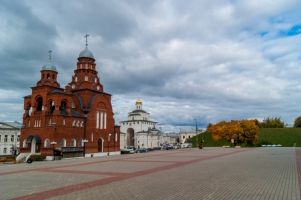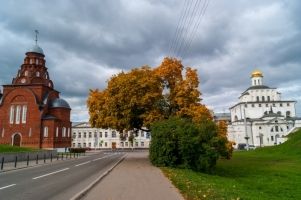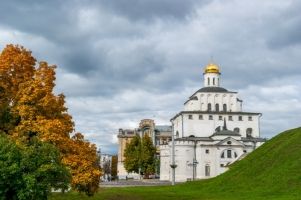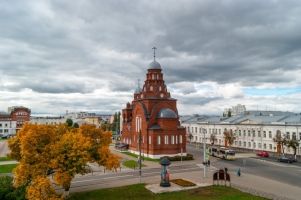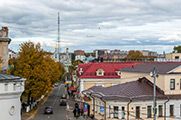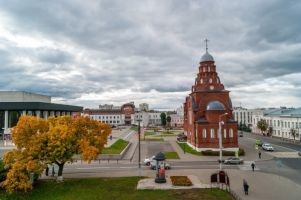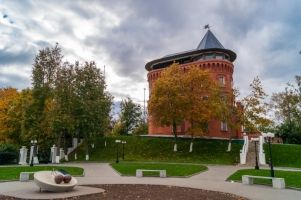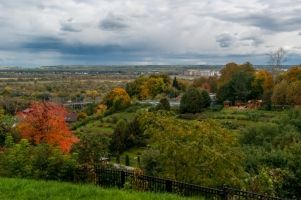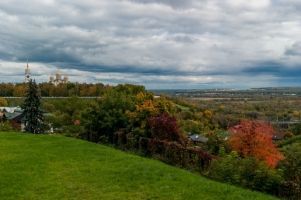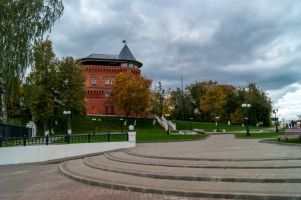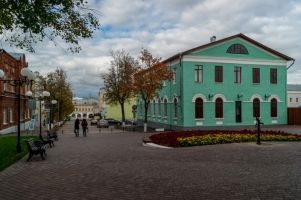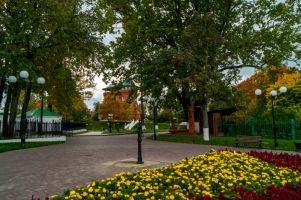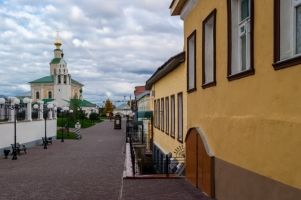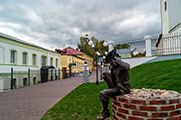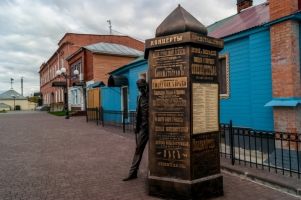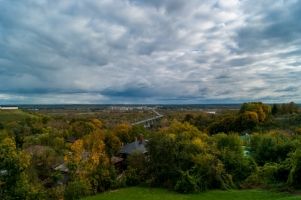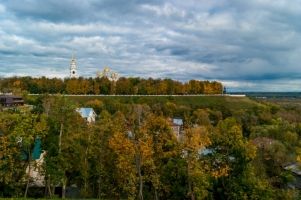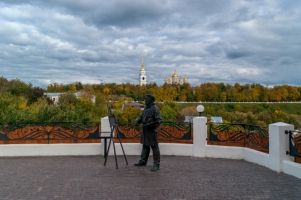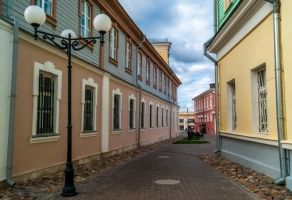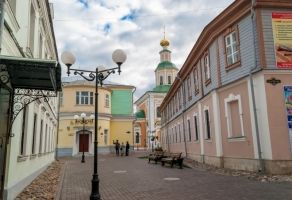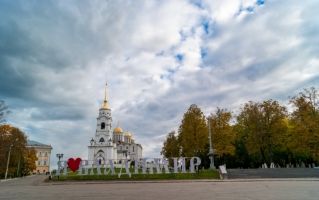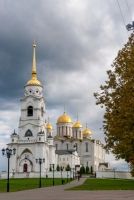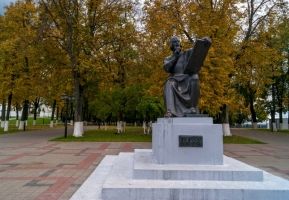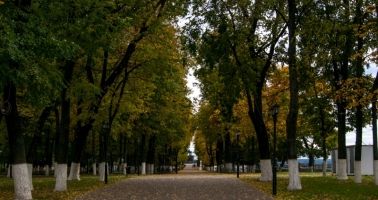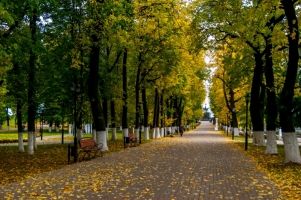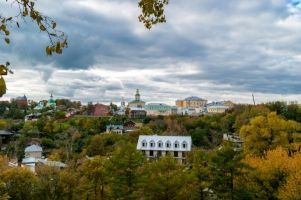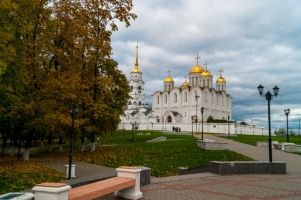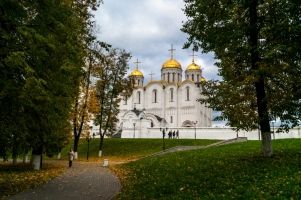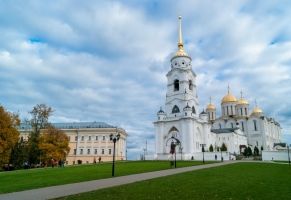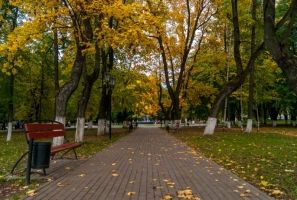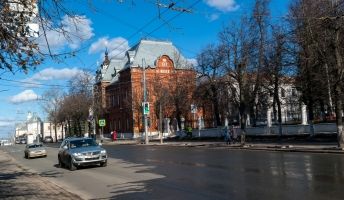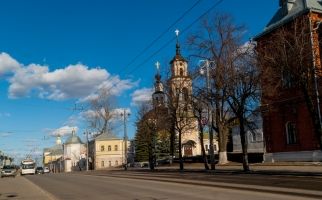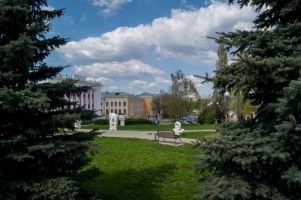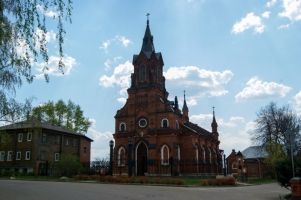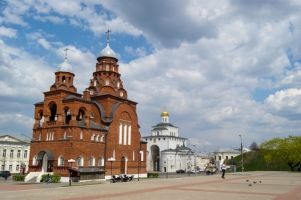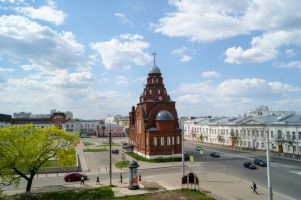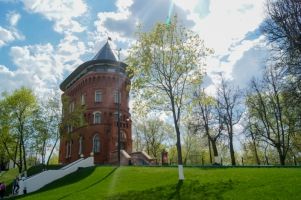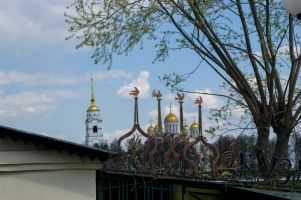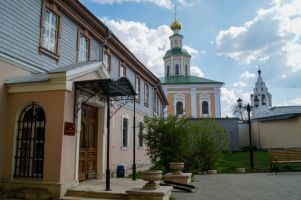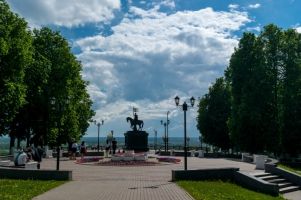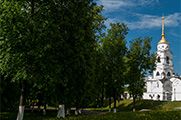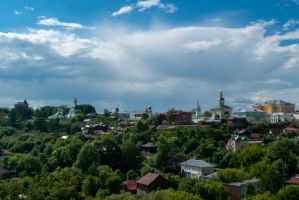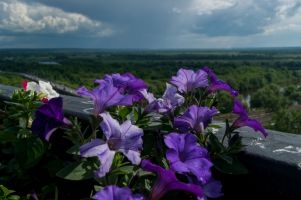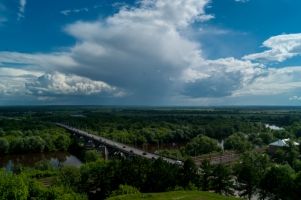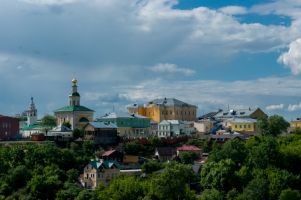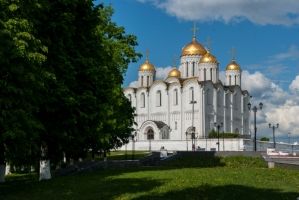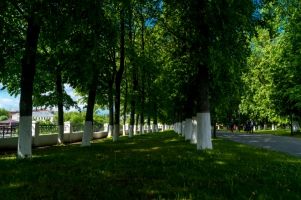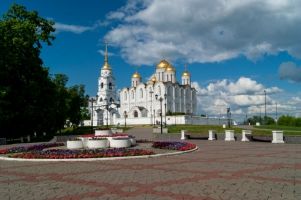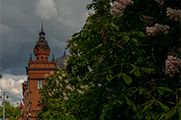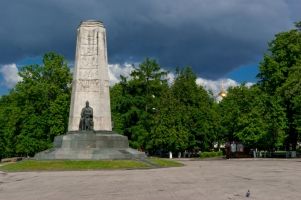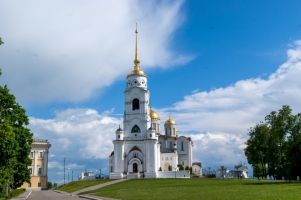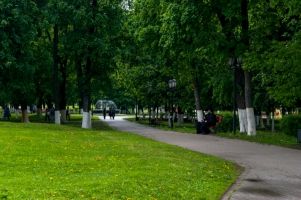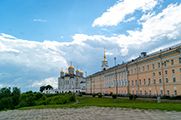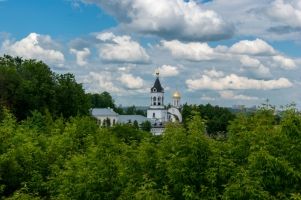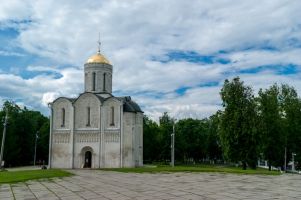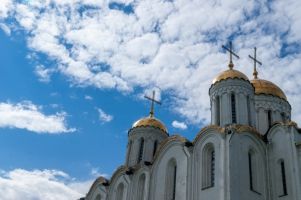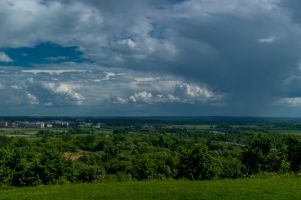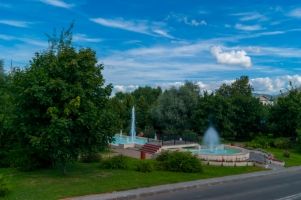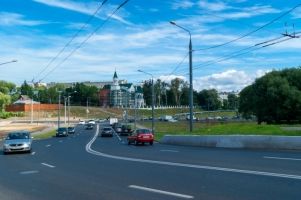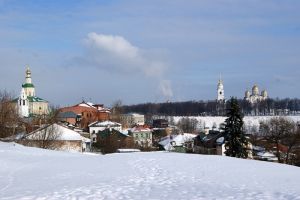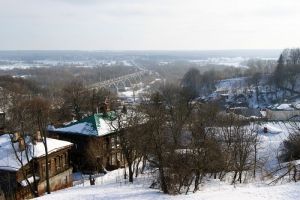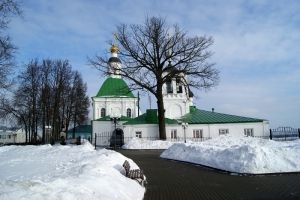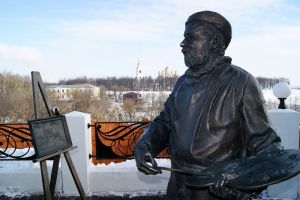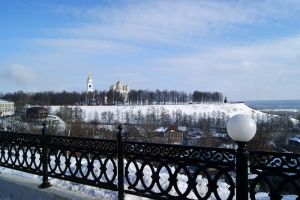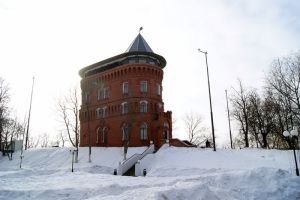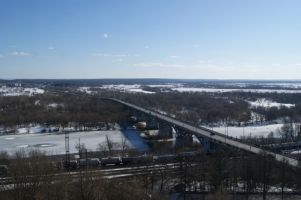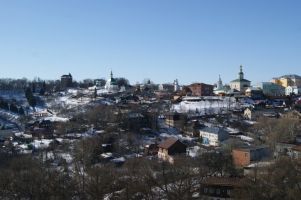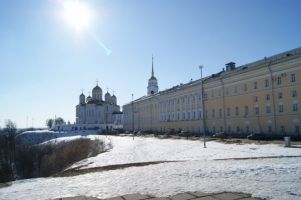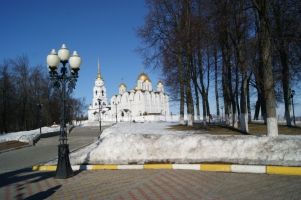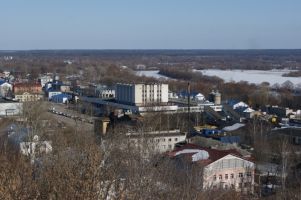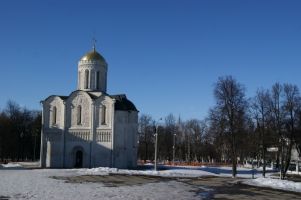Vladimir
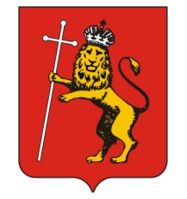
The city of Vladimir is the administrative center of the Vladimir region with a population of 354 827 people (2016). It is located mainly on the left bank of the Klyazma River, 176 km northeast of Moscow, on the M-7 "Volga" highway and the Moscow-Nizhny Novgorod railway (the new Trans-Siberian line). One of the oldest Russian cities, Vladimir is included in the list of historical settlements of the Russian Federation (including updated by the Government of the Russian Federation in 2010). There are three unique historical and cultural monuments in Vladimir, white stone buildings of the 12th century – the Golden Gate, the Assumption and St. Demetrius Cathedrals, included in the UNESCO World Heritage List. Vladimir is part of the Golden Ring of Russia.
History
The territory that modern Vladimir occupies, was mastered by people about 25-30 thousand years ago. This is evidenced by the discovery in April 1981 of the late Paleolithic site of Rusanikha on the bank of the Rpen River on the outskirts of Vladimir. The stone tools (dart heads, piercings, scrapers, etc.) preserved there were similar to those found earlier in the Sungir camp (opened in 1955), located near Vladimir, 8 km east of Rusanikha.
Approximately in the 6th-7th centuries this territory was inhabited by the Finno-Ugric tribe Merya. The penetration of the Slavic tribes here began in the 9th-10th centuries. They gradually assimilated the local population, as a result, the Finno-Ugric tribes retained their memory only in the names of the rivers (Klyazma, Pekha, Koloksha, etc.), ancient cities (Suzdal, Murom, etc.).
In the 10th century these lands are part of the Old Russian state. Vladimir's initial history goes back to the end of the 10th century. The dating of the foundation of Vladimir is still controversial. For a long time in the history of science, the version was accepted that the fortress on the high bank of the Klyazma, named after Vladimir, was built in 1108 by the Grand Prince of Kiev, Vladimir Vsevolodovich Monomakh (great-grandson of Vladimir the Baptist). Accordingly, the 850th anniversary of Vladimir was celebrated in 1958, and in 1960 a famous monument dedicated to this event was erected on the central square of the city (Cathedral Square) (sculptor D.B. Ryabichev, architect A.N. Dushkin). This version is based on one of the oldest, the Laurentian Chronicle, written and preserved until the beginning of the 18th century in the Vladimir Monastery of the Nativity of the Virgin. It is confirmed in the classical works of historians V.N. Tatishchev and N.M. Karamzin. In the 20th century this version was held, in particular, by an expert on the ancient Russian annals, A.N. Nasonov. Also it was considered scientifically justified by our fellow countryman, Doctor of Historical Sciences, Professor N.N. Voronin, one of the largest specialists in the history and architecture of ancient Vladimir.
In the 1990s, the date of the founding of Vladimir – 990, which is referred to by a number of late annals, became widespread (and today is accepted as official). They connect the appearance of a handicraft settlement on Klyazma with the event of the baptism of Rus and with the name of the Kiev prince Vladimir Svyatoslavich (the Baptist). This dating was supported, for example, by such an authoritative researcher as Academician D.S. Likhachev. In the last decade in Vladimir two monuments to Prince Vladimir Svyatoslavich are placed. One is equestrian, with a figure of St. Fyodor standing next to him (opened in 2007, author – a Moscow sculptor, Honored Artist of the Russian Federation S. Isakov), installed on the observation platform of the Park of Pushkin. The other appeared in 2015, in the year of memory of the 1000th anniversary of the Baptist of Rus (the sculptors P.A. Panchenko, AS Krainov), in B. Moskovskaya Street opposite the Trading Rows.
In any case, Vladimir began to grow and strengthen as an outpost of North-Eastern Russia thanks to the efforts of Vladimir Monomakh and his son Yury Dolgoruky. On the high edge of his city-fortress above the Klyazma, as the annals testify, Monomakh built the first stone church of the Savior. Monomakh's heir, Yury Dolgoruky, shortly before his death, upbuilt a new princely court with a white- stone St. George's Church (not preserved), emphasizing the growing importance of the north-eastern outskirts of Kievan Rus.
The development of Vladimir and its strengthening as the capital of the vast and rich Rostov-Suzdal principality began in 1157 with the eldest son of Yury Dolgoruky – Andrey Bogolyubsky. He built himself a country residence Bogolyubov-city and at the same time strengthened Vladimir, as an impregnable fortress with the main battle tower and the main entrance – the Golden Gate (1158-1164) and four more fortress gate towers. In addition, the new capital was decorated with the majestic white-stone Assumption Cathedral (1158-1160).
The strengthening of the Grand Duke's power and the cultural flourishing of Vladimir continued under Vsevolod III the Big Nest. A magnificent princely palace was built with the court Cathedral of St. Demetrius (1194-1197). Severely damaged during the fire of 1185 the Assumption Cathedral was built with new walls (1185-1189). A stone wall of the Vladimir Detinets (the Kremlin) with battle gates was erected, protecting the princely-episcopal residence from the troubled city. The princely Monastery of the Nativity of the Virgin was founded with its white-stone cathedral (1192-1195). Vsevolod III's wife, Princess Mary, founded the Assumption (Princess) Monastery with a brick cathedral (1200-1201). So the unique architectural ensemble of ancient Vladimir in the 12th-13th centuries was formed, a significant part of which adorns the city to this day.
A serious blow to Vladimir was caused by the Mongol-Tatar invasion in 1238. Despite stubborn resistance to the enemy, the city was plundered and burnt. Later, Vladimir was repeatedly subjected to the Horde raids, the most brutal of which was in 1293. However, after this catastrophe, the city remained the nominal capital of the Russian lands, since it was under the arches of the Assumption Cathedral in Vladimir that the wedding of the grand reign took place, and the Vladimir princes were recognized by the Horde as the oldest in Rus. This status has become even stronger since 1299, when Vladimir became the residence of the metropolitans of all Rus. The title of the Grand Duke of Vladimir in 1252 was also given to the legendary Russian commander Alexander Nevsky, and in 1263 he was buried in the Nativity Monastery in Vladimir (until 1724, when, according to the decree of Peter I, his relics were transferred to the Alexander Nevsky Lavra in Saint-Petersburg). Near the walls of the Nativity Monastery, in the square near the Vladimir Planetarium, a monument to Prince Alexander Nevsky was opened in 2003.
In the 14th century the struggle between Moscow and Tver princely dynasties for the title of the Grand Duke of Vladimir intensified. Moscow princes claimed not only for the Vladimir historical traditions, but also for the relics of the 12th century created in Vladimir. In 1380, on the eve of the Battle of Kulikovo, Dmitry Donskoy brought to Moscow from the Vladimir Cathedral of St. Demetrius an ancient icon of Dmitry Solunsky. In 1395, during the invasion of Tamerlane, the most important shrine of Vladimir – the icon of Our Lady of Vladimir – was also transferred to the Assumption Cathedral of the Moscow Kremlin to protect the city from the conqueror, and no longer returned to Vladimir.
In 1408 Prince Vasily I sent to Vladimir an artel of icon-painters, led by Andrey Rublev, to resume the painting of the Assumption Cathedral, burnt after the raid by the hordes of Khan Yedigey. Today, up to 300 square meters of these legendary frescoes have been preserved in the Assumption Cathedral. In 1995, the bronze sculpture of Andrey Rublev (author – the Moscow sculptor O.K. Komov) was opened at the beginning of the Park of Pushkin (on Cathedral Square).
By the beginning of the 16th century, Vladimir became an ordinary city of the Moscow State, its development was slowing down. The city was managed by governors appointed from Moscow. At the beginning of the 17th century, inhabitants of Vladimir played a big role in liberating the country from the Polish-Lithuanian intervention. It is known that in 1609 they rebelled against the henchman of False Dmitry II, the governor M. Velyaminov, throwing him with stones. In 1614 the neighborhood of the city was devastated by detachments of the Lithuanian nobleman Lisovsky.
After the Time of Troubles in Russia, stone construction was resumed in Vladimir, which was maintained with the spirit of the ancient ensemble of the city. However, in the 18th century the ancient monuments of the city suffered considerable damage: a wooden fortress was broken, and a spontaneous demolition of the shafts began; victims of the fire in 1778, the earliest white-stone Savior and George temples of the 12th century were dismantled and replaced by new ones; the top of the Golden Gate was rebuilt.
In 1778, by decree of Catherine II, the Vladimir vicegerency was established, and from 1796 – Vladimir governorate consisting of 14 counties, the center of which was Vladimir. In 1781, the official coat of arms of the city of Vladimir was approved: in the red field a lion standing on its hind legs was depicted, with a crown on its head and a long silver cross in its right front paw. Lion, symbolizing strength, courage, power, on the coat of arms of Vladimir appeared in the 12th century, as a birthmark of the Vladimir-Suzdal princes. It is not by chance, all kinds of images of lions can be seen in the decorative design of all Vladimir white stone churches. The historical coat of arms of Vladimir was restored in 1992 as the official symbol of the city.
In connection with the administrative elevation, there was also a certain cultural and economic rise of the city. In accordance with the regular building plan in 1781, the construction of large stone public and residential buildings began in the city. At the same time, the remains of the ancient shafts of the 12th century, the old highway of the longitudinal Grand street, the square in front of the Assumption and St. Demetrius cathedrals were preserved (originally it was planned to be built up by two buildings of the Shopping Rows). However, in 1785 a long building for public authorities was built between the cathedrals, which somewhat violated the ancient beauty of the city center (this building now houses the cultural and educational center, called "The Chambers", of the Vladimir-Suzdal Museum-Reserve). On the north side of the Grand Street, an entire arcade of the Trade Rows (1787-1790) occupied the whole quarter.
In the middle of the 19th century the first provincial public library (1834), the drama theater (1847), the provincial museum of local lore (1862) were opened in Vladimir. In 1841, the men's gymnasium was transferred to a new building in the center of Vladimir (now the Vladimir Art School), which was added with the preservation of architectural stylistics to the building of the Noble Assembly, which appeared on Cathedral Square as far back as 1826 (now the Center for Culture and Art on Cathedral Square, former House of Officers). In the middle of the 19th century the first media appeared – Vladimir provincial news. A.I. Herzen served a link in Vladimir in the years 1838-1840, he became the first editor of the unofficial part of the provincial news.
In the late 19th - early 20th centuries, new educational institutions were built in the city. In 1870 appeared the first female gymnasium (now – the secondary school number 1), in 1885 – Zemstvo craft school, built with funds of I.S. Maltsov (now – the Vladimir Aviation Mechanics College), in 1902 the city parish school was opened (now – the Lenin District Administration of Vladimir), and in 1908 – the real school (now – the building of the philological faculty of the VlSU).
In the second half of the 19th century the Moscow-Nizhny Novgorod railway passed through Vladimir (opened in 1861). However, its track economy, located at the base of the southern slope of the city, spoiled the beautiful panorama of Vladimir with the ancient monuments of white stone architecture. In the same period the city telegraph began to operate, and by the end of the century – the city telephone network, water supply. In 1908, the first coal-fired power plant was built. However, industrial development almost did not affect Vladimir, despite the fact that the city was the center of the province with a large factory production. Until the early 20th century only a few small enterprises (paper-weaving, brick, vodka production) worked in Vladimir, the largest among which was the diocesan candle factory. In fact, Vladimir remained a small bureaucratic-philistine city.
Rapid industrial development of the city of Vladimir began in the Soviet period. In 1929, the city was included in the Ivanovo Industrial Region. In 1932 enterprises appeared that formed the basis for the future industrial breakthrough of the city: the plant "Himplastmass" (nowadays – the Vladimir Chemical Plant) and one of the first-born of the Russian instrument making industry – the Automotive Instrumentation Plant. During the Great Patriotic War, the construction of the Vladimir Tractor Plant began, the first stage of which was put into operation in April 1945, and by that time the first 500 tractors were produced. In 1948, the enterprise produced a 10 000th tractor, and in 1988 – a million (currently the plant does not work). Around these enterprises there were large residential areas, the city began to expand to the north and east.
August 14, 1944 by the Decree of the Presidium of the Supreme Soviet of the USSR the Vladimir region was established, the administrative center of which was the city of Vladimir.
During the Great Patriotic War, Vladimir was one of the largest evacuation centers in the European part of the country. In the city there were 18 evacuation hospitals, residents of the city surrendered about 40 thousand liters of blood. During the Great Patriotic War, Vladimir gave the country 24 Heroes of the Soviet Union.
Economy
In the post-war period, the industrialization of Vladimir continued. In 1955, large enterprises – the Vladimir Electromotive Plant (VEMZ) and the Electrical devices Plant (Elektropribor) – entered service. At present the city is a large industrial center of Russia.
The leading place in the economy is the production of machinery and equipment: the Plant of precision instruments and engineering (VPO Tochmash) produces defense products for the nuclear industry (since 2008 the plant is part of Rosatom State Corporation), as well as civilian use (gas meters, "Vesna" watch, electrical appliances for cars, etc.); the Vladimir Electromotive Plant (VEMZ) is the largest Russian manufacturer of asynchronous electric motors (a part of the Russian electrical concern "RUSELPROM"); "NIPTIEM" is known in Russia and abroad as a leading scientific and technical center for research, development and production of low-voltage asynchronous electric motors (also included in "RUSELPROM"); the Vladimir Machine Tool Plant "Technika" designs and produces the most modern machines (grinding, milling, turning, specialized machines of various technological purposes), together with "Center for Laser Technologies" produces multi-axis automated machines for laser thermal hardening; "Zavod Avtopribor" specializes in the production of components for car assembly and agricultural enterprises in Russia and CIS countries, and also produces a range of products in demand in the markets of furniture production, power tools and energy-saving technologies; the Vladimir Electrical devices Plant (Elektropribor) produces unique high-tech defense products, communication facilities for civil aviation and railway transport, technical means of alerting the population through radio channels and digital networks, towers and pillars of communication, antenna-mast devices, mechanical grills for wastewater treatment, LED traffic lights, etc.; NPO "Magneton" is the largest Russian manufacturer of permanent magnets, magnetic systems and separators. In addition, ground electrotechnical equipment for the oil industry produces the "Electron" plant, located in Raduzhny, near Vladimir, one of the Russian leaders in its industry. Vladimir's important and oldest branch of industry is chemical production: the Vladimir Chemical Plant is one of the largest Russian plastics manufacturers for various industries (from cable and automotive to food and construction); LLC "Akrilan" specializes in the production of paint and varnish materials based on aqueous dispersions of polymers; LLC "Dow Izolan" produces various types of polyurethanes for the heat insulation of pipes, building sandwich panels, refrigeration equipment, interior decoration of cars, upholstered furniture, shoes, etc .; CJSC "Blockform" produces polyurethane foam materials for heat and waterproofing, foam rubber, sorbents for oil products, etc .; CJSC "Polycell" offers a wide range of quality reagents used in well drilling, enhanced oil recovery, and as a component in the production of household chemicals; LLC Scientific and innovative enterprise "VLADIPUR" produces a variety of polyurethane foam products for its own technological development and sells it in many regions of Russia and the CIS. Created in 2011, CJSC "RM Nanotech" (together with OJSC "RUSNANO") produces nanostructured membranes and roll modules based on them for purification of drinking water, seawater desalination, processing of food products, use in medicine and biotechnologies, etc.
CJSC "STES-Vladimir" is one of the first in Russia and so far the only large company specializing in the production by its own technologies of heat insulation materials made of foam glass (it does not burn, does not rot, serves almost forever) at European quality level for construction of residential houses and public buildings. Foam glass of the Vladimir enterprise is bought by large corporations (Gazprom, Transneft, Skolkovo), during the last reconstruction they have insulated the Tretyakov Gallery, actively used in the construction and reconstruction of the Moscow metro stations. It even began to be exported to the EU countries. The Chairman of the Government of the Russian Federation D.A. Medvedev met with the production of innovative building material during his visit to Vladimir on June 14, 2016. The example of "STES-Vladimir" discussed the development of the construction materials industry in Russia at a meeting that the prime minister held in the Vladimir region administration.
In the field of scientific research and development, the Federal Center for Animal Health "ARRIAH" ("VNIIZH") located in the Yurievets microdistrict (Vladimir), which specializes in the production of ecologically safe veterinary medicinal products, is known.
In the field of light industry in Vladimir there are: the industrial group "Slavyanka Textile", which produces textile products for technical purposes; Garment factory "Pobeda" (part of the holding "Children's Clothing"), which produces women's and children's clothes, as well as bed linen; Garment factory "AVIKO" for sewing a modern women's coat, etc.
Sights
Increasing importance in the economy of the city is acquired by tourism. In the early 1970s Vladimir became one of the tourist centers of the Golden Ring of Russia. This was facilitated by the work of the Vladimir-Suzdal Museum-Reserve (VSMR), founded in 1958, and the presence of unique sights. First of all, these are remarkable white stone monuments of the 12th century. (Golden Gate, Assumption Cathedral, Cathedral of St. Demetrius), in 1992 included in the UNESCO World Heritage List. Golden Gate and Cathedral of St. Demetrius were several times depicted on the reverse of commemorative coins issued by the Bank of Russia (in 1995 and in 2008).
In addition to the noted monuments of architecture, the attention of tourists is attracted by the Assumption Cathedral of the Princess Monastery (the turn of the 15th-16th centuries), in the interior of which the painting of the middle of the 17th century remained. In comparison with other cities of the Golden Ring of Russia, parish churches of the 17th-18th centuries in Vladimir are not so numerous. Architecturally the most interesting are the churches of the Assumption of the Virgin (Bogoroditskaya, given to the Old Believer community) (1644-1649), St. Nikolas in Galei (1732-1735), St. Nikita (1762-1765), St. Nikolas-Kremlin (1761-1764). To the monuments of the late 19th century refers to the pseudo-Gothic Catholic Church of St. Rosary of the Blessed Virgin Mary (1892-1894). In total there are about 240 state-protected buildings of the 18th-19th centuries in the city.
The Vladimir Historical Museum (1900-1906) houses and constantly modernizes the historical and local history exhibition of VSMR. In the mid-1970s, VSMR opened a military historical exhibition in the Golden Gate, the Crystal Museum, the Old Vladimir exposition in the water tower, the Stoletov Memorial House Museum. In 1992, the museum cultural and educational center "The Chambers" was opened in the former building for public authorities, as well as the regional Center for Fine Arts in the former governor's house.
Many people know the famous Vladimir central – a prison for especially dangerous criminals, built in 1783 by the decree of Catherine II. At different times here were kept the revolutionaries M.V. Frunze and N.E. Fedoseev, the poet-philosopher D.L. Andreev, Lieutenant-General of Aviation V.I. Stalin, political and public figure V.V. Shulgin, the singer L.A. Ruslanova, film actress Z.A. Fedorova and other famous people. In 1996, a museum of the history of the Vladimir Central was established in the territory of the prison by the forces of VSMR.
In Vladimir, there are a number of cultural centers and museums that are attractive for tourists. You can see fine examples of folk crafts and crafts of the Vladimir region in the House of Folklore and the House of Masters of the Regional Center of Folk Art. In recent years, interesting museums not only for adults but also for children have opened in Vladimir: Spoon Museum, Gingerbread Museum, Babusya-Yagusya Fairy-tale Museum, Galileo Museum of Entertaining Sciences, Museum of Optical Illusions and Entertaining Sciences DA VINCI.
Famous people
In Vladimir, many famous people were born and worked: M.P. Lazarev (1788-1851), Russian navigator, discoverer of Antarctica, admiral, commander of the Black Sea Fleet; A.G. Stoletov (1839-1896), Russian physicist, discoverer of the first law of photoelectric effect, creator of the physical laboratory of Moscow University and his deserved professor; N.G. Stoletov (1831-1912), Russian commander, general from infantry, commander of the Bulgarian militia in the Russian-Turkish war of 1877-1878, one of the leaders of the Shipka defense; N.N. Zlatovratsky (1845-1911), Russian writer, publicist, whose stories refer to the so-called "peasant polite letters", reproducing all the small things of peasant life and folk customs; V.I. Taneyev (1840-1921), Russian philosopher, lawyer and public figure from the noble family of Taneyevs; S.I. Taneyev (1856-1915), Russian composer, pianist, scholar, music and social activist from the noble family of Taneyevs, a disciple of P.I. Tchaikovsky, director of the Moscow Conservatory in 1885-1889; I.S. Shmelev (1873-1950), Russian writer and publicist, worked in Vladimir in 1901-1908; N.N. Voronin (1904-1976), doctor of historical sciences, professor, archaeologist, one of the largest specialists in ancient architecture; M.K. Tikhonravov (1900-1974), designer of space and rocket technology, Doctor of Technical Sciences, Professor, Hero of Socialist Labor; Yu.B. Levitan (1914-1983), the announcer of the All-Union Radio, People's Artist of the USSR, who was called the "Voice of Victory", on the eve of the celebration of the 70th anniversary of the Victory in the Great Patriotic War, a monument to Levitan was unveiled in Vladimir (sculptor – I.A. Chernoglazov); E.A. Evstigneev (1926-1992), People's Artist of the USSR, began his acting career in the Vladimir Regional Drama Theater; A.V. Batalov (born in 1928 in Vladimir), People's Artist of the USSR, film director, screenwriter, etc.
The Vladimir school of gymnastics became world famous. It prepared such outstanding athletes as N.E. Andrianov (1952-2011), seven-time Olympic champion; L.V. Burda (1953), two-time Olympic champion, widow of N. Andrianov; V.N. Artemov (1964), four-time Olympic champion; Yu.N. Korolev (1962), multiple world champion; Yu.S. Ryazanov (1987-2009), the champion of Europe and Russia.
 Tourism portal of the
Tourism portal of the